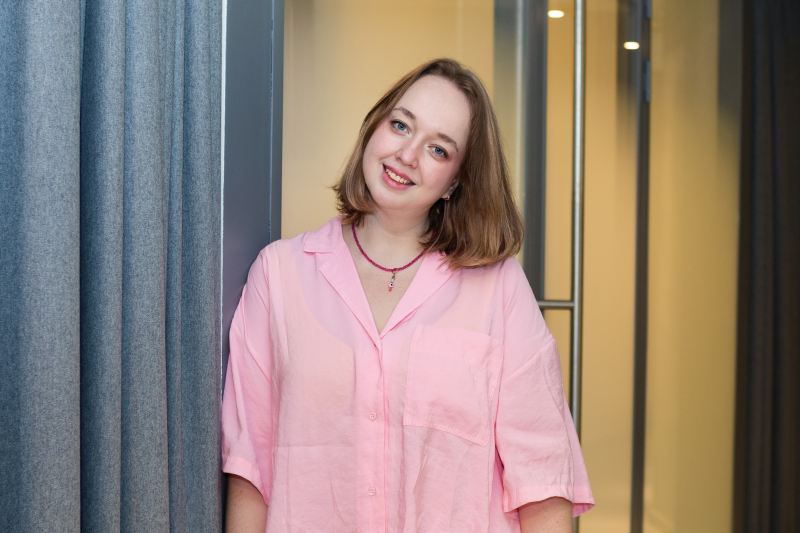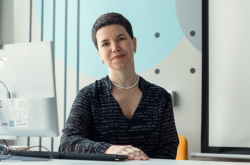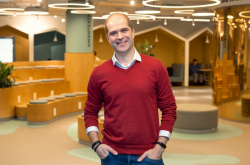How did you get into ITMO?
In 2015 when I was about to receive my Bachelor’s degree in PR and Media Relations from Lipetsk Management Institute, I realized that the only thing I could do in my hometown as a marketing specialist was creating typical banners that would appeal to a target audience. Moreover, my year-long career at the city’s major company made it clear that I wasn’t learning anything new there. And what’s more, most of the handy skills I’ve got came from taking ITMO’s Marketorium contest during my Bachelor’s studies. Then, my friend told me about ITMO’s Master’s programs and encouraged me to apply. I saw that as an opportunity to gain the so-needed experience, which I lacked, and do cool things in a creative environment. That’s how I got to study innovative marketing at ITMO.
You started teaching at ITMO in 2018. Why did you choose to become a lecturer?
When I still lived in my hometown, I worked in the department of youth innovation projects of the October Palace of Youth. There, I held various workshops and came up with ideas for future events. I was so into it!
During my Master’s years, my colleagues offered me a teaching position. Back then, I was nervous and doubted myself but I still decided to give it a try. I reasoned that if I got this offer, it means that someone needs me, and stayed at ITMO.
What do you do here?
I teach innovative marketing and related topics – new market research, visual communications, branding, content creation, and integrated marketing. I also have open lectures at the Marketorium School where I introduce young professionals and students from ITMO and other universities to the world of marketing. For the past six months, I’ve been extremely active on my TikTok channel, where over 500 students from ITMO watch my videos. I have some background in design, too, that’s why I chose to talk about how to create successful presentations on my social media. Being able to present your work efficiently is a vital skill. Many great projects don’t get the deserved attention because of poor presentations. For instance, some speakers elaborate more on the creating process than on the results of their work, which are actually of a bigger value to potential investors. I’m happy to see that students use my tips in their presentations.

Anastasia Bulygina’s channel on TikTok. Credit: tiktok.com/@nastya_feia
What challenges do you face as a teacher?
While Bachelor’s students usually have no doubt in my competencies, Master’s students like to question everything. They want to learn from professionals and they expect real-life cases and statistics from specialists in creative industries. Yet not everyone knows that the success of creative work can hardly be measured in figures unless we’re talking about large corporations, like, for instance, Ozon, that come up with special metrics to analyze their work.
It’s sometimes hard to say whether others appreciate the efforts you put into your work. I see students who got into a university because their parents said so or they wanted to avoid the army. So, no matter how hard I try, they couldn’t care less. Even if I have 20 students who are deeply interested in studying, I can still be upset when I see someone who isn’t. During one of my online classes, a student said that they could’ve just watched YouTube instead and I feel them. This is my way to fight my fears: if 20 people enjoy my work, then someone else will do, too, and the same goes for my TikTok videos.
When I decided that my classes should be more fun than YouTube videos, I started to play the truth or dare game with my students who just started my course. During the game, we learn more about each other and talk about our favorite YouTube channels, books, and songs. Then, I try to use these examples in my classes. This way, students feel heard, communicate and study better, and I, in turn, discover something new. Recently, for example, I started watching a YouTube channel about game design.
How else do you keep your students engaged?
We play a lot. My colleague and I created an RPG-like story on branding for our joint class where students could choose what’s going to happen next. Each team had their own unique journeys since they not only received scores for their answers but also tossed a die, which added an element of chance to the game. At first, students had to get used to playing, and then, after they’ve gone native, they have to deal with more complex tasks: to present a case or come up with a product name, for instance. Playing helps students enhance their creativity and learn to make decisions fast.
We strive to make sure that our students have projects for their CVs by the end of the course. We collaborate with various companies that provide real-life marketing cases for our students. By working on these cases, students get to figure out their goals, objectives, subject matters, and scope of studies, as well as learn how to do research, build marketing strategies, and develop creative solutions.

Anastasia Bulygina. Photo by Dmitry Grigoryev / ITMO.NEWS
This semester, we plan a visit to the Erarta Museum. There, we will show our students how an art metaphor becomes a marketing project and thus creates a cultural reference that we can then understand. What’s important here is that students should learn to listen to their inner voices and understand what associations arise and how they can make other people feel the same.
Not so long ago, my colleagues and I discussed the soundtrack of The Lord of the Rings movie. When the Shire theme catches your ear, you feel a sort of déjà vu, as if you are five years old once again and you are staying in the country at your grandma’s. What can we do to achieve a similar effect and make our customers feel all nice and cozy? The thing is, when this theme was in the making, no one knew how to make it right and they turned to other compositions. So, as we can see, marketing is a large art laboratory.
What do you like best about teaching?
I enjoy hearing what others think about my work, for instance, when someone shares that they landed a job thanks to my classes or changed their views on ads. In my work, I follow the progressive JPEG method, that is, students develop their projects gradually but from the very beginning they need to know how their ideas will be implemented. Sometimes, students propose such unconventional solutions that I can’t even think of a way to bring them to life yet students present their final projects and demonstrate great results.
It’s pure happiness to see how my students start to succeed. Once some of my students had to find a way to promote blockchain technologies on the European market. It was a rather challenging task since European and Russian markets are quite different. Yet they did a great job!
What do you think helped you win the ITMO.EduStars contest?
It’s just like our game. There are students and teachers who assess your work, plus an element of chance. All of our lecturers are top-tier professionals, so anything could change the outcome, from a timely joke to a positive review from a student who was in a good mood.
I have nothing but admiration for lecturers from other faculties. I enjoy Irina Timofeeva's Instagram page about animals. While I always seek inspiration in art, culture, and mass media, I’ve never thought of nature as a way to find answers to marketing problems. This blog gave me a different perspective. So I think everyone deserves to hear that they are great teachers.

Anastasia Bulygina and other ITMO.EduStars winners. Photo by Dmitry Grigoryev / ITMO.NEWS
What do you do in your spare time?
I’m an avid gamer. I see no difference between movies, books, and games. No matter what you choose, they are still products of the human mind – exciting, interesting, and interactive. I’ve recently finished Horizon Zero Dawn and I can highly recommend it. This game brings up many pressing issues and shows us what might happen if we don’t start to care about our planet. Now I started The Witcher 3: Wild Hunt because I enjoyed Andrzej Sapkowski's novels.
I also love hanging out with my friends, traveling, and creating new projects. My current read is The Thursday Murder Club by Richard Osman. I guess, if it wasn’t for marketing, I would have probably been a detective by now.





